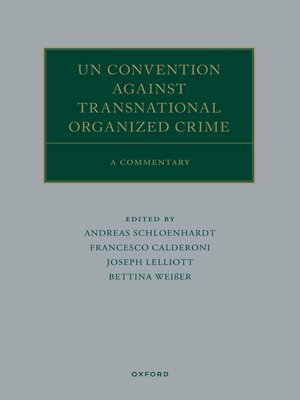UN Convention against Transnational Organized Crime
ebook ∣ A Commentary · Oxford Commentaries on International Law
By Andreas Schloenhardt

Sign up to save your library
With an OverDrive account, you can save your favorite libraries for at-a-glance information about availability. Find out more about OverDrive accounts.
Find this title in Libby, the library reading app by OverDrive.



Search for a digital library with this title
Title found at these libraries:
| Library Name | Distance |
|---|---|
| Loading... |
This book offers a comprehensive, article-by-article legal commentary on the United Nations Convention Against Transnational Organized Crime and its Protocols on trafficking in persons, smuggling of migrants, and trafficking in firearms and ammunition. The Convention- often referred to by the acronym UNTOC- was approved by the UN General Assembly on 15 November 2000 and made available for governments to sign at a high-level conference in Palermo, the heartland of the Italian Mafia, on 12-15 December 2000. For this reason, UNTOC is sometimes also referred to as the 'Palermo Convention'. The Convention entered into force on 29 September 2003. The purpose of UNTOC is to promote cooperation to prevent and combat transnational organized crime more effectively. UNTOC seeks to promote consistency among national legal systems and set standards for domestic laws so that States parties can effectively combat transnational organized crime. UNTOC is supplemented by three protocols: the Protocol against the Smuggling of Migrants by Land, Air, and Sea, the Protocol to Prevent, Suppress, and Punish Trafficking in Persons, especially Women and Children, and the Protocol against the Illicit Manufacturing of and Trafficking in Firearms, their Parts and Components, and Ammunition. Article by article, this books presents the text of each provision of the Convention and the Protocols, followed by a systematic analysis of their background and negotiating history, their interpretation by the Conference of the Parties and its working groups, in judicial decisions by domestic and international courts, , in the academic literature, and in official material published by international organisations, chief among them the United Nations Office on Drugs and Crime (UNODC), the guardian of UNTOC and the Protocols. The authors offer critical, scholarly commentary. The book serves as a compendium for those using, researching, or studying provisions under UNTOC and the Protocols and as a handbook for those charged with implementing and enforcing them.







